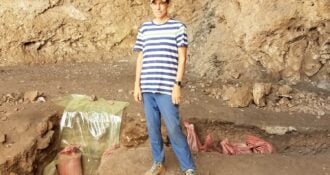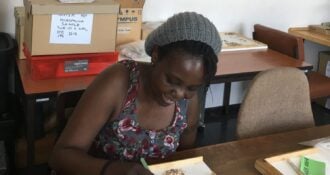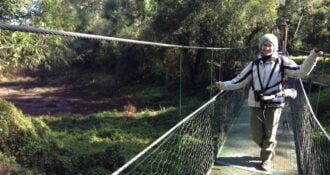Hailay Reda is a Leakey Foundation Baldwin Fellow from Ethiopia. He is a PhD candidate at the University of Oregon. He has also been awarded a Leakey Foundation research grant for his project entitled “Reconstructing the paleoecology of Woranso-Mille hominins using cercopithecids.”

Left to right: Hailay Reda with Leakey Foundation grants officers Paddy Moore and H. Gregory at the 2017 AAPA conference in New Orleans
Q: How did you first become interested in science?
A: This is an interesting question. Born to a religious family, I was instructed and shaped with religious manners. I was also sent to parochial school at an early age. So I grew up in the notion that every thing was created and well ordered under the will of the creator. This was /is a prevailing idea in the community I grew up with. I had an interest in observing nature and the processes of nature, but the answers I got to my questions related to these interests were not scientific. The answers were from religious perspectives, primarily when I used to ask families in my community. I believe this dampened my curiosity to inquire further during my childhood. It was only in high school that my interest in science emerged.
Q: How did you become interested in your current field?
When I was in high school, grade 12, I learned the concept of evolution. That was the inception of my interest in this field. I started to accept ideas that are supported with evidence. This continued in college, where I joined the department of biology. During college, I took genetics and evolution, among other courses. These further increased my understanding about the concept of evolution. As a result, my interest in this area continued to grow. Further, I started to follow the news on human evolution research in Ethiopia. Two years after my college graduation, I joined an institute that aims to be a center of excellence in human evolution research and study of the ancient environments. Then, I had a chance to study fossils through participating in different research projects – Woranso-Mille is one of those.

Photo from a fossil survey at the Woranso-Mille Research Project, Afar, Ethiopia.
Front row left to right: Afar police (name unknown), Project leader Dr. Yohannes Haile-Selassie, Degu. Back row left to right: Afar police (name unknown), Alemayehu Asfaw, Hailay Reda, unknown student, Burhan, Habib, Beverly Saylor, Osama, Kebede Geleta, Ali Ibrahim.
Q: What can you tell us about your Leakey Foundation-supported research project?
A: It was previously assumed that only one species of early human ancestor was present between 3.6 and 3 Ma years ago in the Afar Region, Ethiopia. Large samples from Hadar, one locality in the Afar, suggest the presence of only one species. The same result was found through the description of early human fossil remains from Dikika and Maka, also from the Afar Region. However, new discoveries from Woranso-Mille, Afar, Ethiopia, have indicated the presence of more than one species of early human ancestors in the 3.6 to 3 Ma time range. Thus, the long held assumption has been challenged due to the diversity of early human species at Woranso-Mille, an area closer to the other contemporaneous Afar localities. The discoveries also raised ecological questions. Was Woranso-Mille distinct in its paleoenvironment from Hadar and other Afar contemporaneous localities? Were the early human species (Australopithecus afarensis and Australopithecus deyiremeda) different in their habitat preferences? With these grand questions, the project aims to reconstruct the paleoenvironments at Woranso-Mille, and also compare the habitats of the two early human species using associated fossil monkeys.
These fossil monkeys are important to reconstruct habitats of early human ancestors. First, they are abundant in the fossil record in many of the Afar sites. Second, they have been shown to be useful paleoecological proxies to reconstruct habitats of early human ancestors. Third, fossil monkeys from Africa have been considered as good models to understand the paleoecology and diet of early human ancestors. Fourth, both early human ancestors and fossil monkeys experienced environmental changes that required similar adaptive strategies.
What is more important is their phylogenetic propinquity to humans. Thus, three major tasks are proposed in this project: taxonomic description of fossil monkeys, analysis of their relative abundance, and their dietary adaptation inferred from dental functional morphology and isotopic method. With the taxonomic description, it will be revealed what species of fossil monkeys were present at 3.5-3.3 Ma Woranso-Mille. Then, I will compare Woranso-Mille with other contemporary Afar localities in terms of relative abundance of fossil monkeys and their dietary category and determine whether fruit, grass or leaf eaters dominated a locality.

Q: How did you feel when you found out you had received your Leakey Foundation grant?
I was so happy when I first saw the congratulations email from The Leakey Foundation! The major objective of my research is to reconstruct the paleoecology of early human ancestors from Woranso-Mille, a site located in the Afar Region of Ethiopia. To accomplish my research activities, I have to travel to Ethiopia and other African countries to collect my data. Therefore, the research grant from the Leakey Foundation is so crucial to conduct the data collection. This will help advance my career in different ways. First, this provides me an opportunity to carry out research applying advanced methods. Second, this gives me a chance to publish the research results. I can also present my findings in conferences or workshops that are important platforms to make connections with other researchers. All these are useful to advance my career.
Q: What excites you about your work?
Woranso-Mille has fossils from more than one early human ancestor, unlike other contemporaneous Afar localities- Hadar, Dikika, and Maka even though these localities are geographically close to Woranso-Mille. Despite the geographical proximity, there is variation in the diversity of early humans between these sites. So, it is exciting to learn whether Woranso-Mille was distinct in its environment compared to the other sites.

Q: Can you tell us about something something interesting you’ve discovered in your research so far?
My research is still in progress. As a result, data collection and analysis are not yet completed. Although it is provisional, a preliminary study indicates higher diversity of fossil monkeys at 3.5 to 3.3 Ma Woranso-Mille horizons compared to the other Afar sites equivalent in age. This probably suggests the distinctiveness of Woranso-Mille in terms of its paleoenvironment.
Watch this video to learn more about Hailay Reda’s fascinating research!






Comments 0